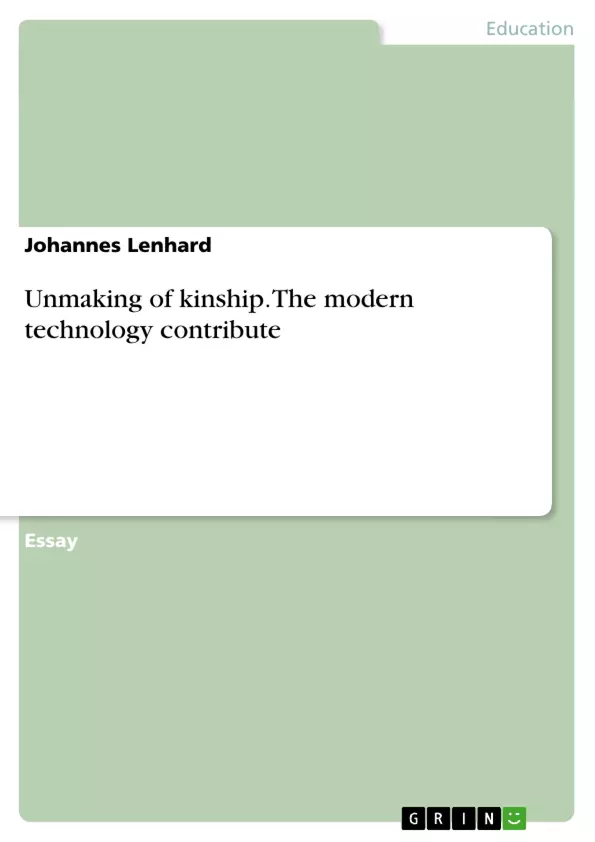The two Boleyn girls struggled to keep up with King Henry VIII’s demands in the fifteenth Century. Mary having been the King’s mistress for assumingly two years, her sister Anne takes over to enchant the Henry and become Queen. Her fertility was, however, not exactly appropriate in the eyes of the King – no son was ever to be born from her womb. Henry had to find ways to get rid of her and her unbearable ‘inability’. So at least runs the story that Justin Chadwick tells about the ‘two Boleyn girls’. In their case, new reproductive technologies and genetic prediction would have ‘made’ kinship indeed. Would it only have been possible to help a little bit with the pregnancy, would it have been possible to predict (and change) the gender of the heir, the Boleyn family could have had a glorious future. NRTs had ‘made kinship’, had sustained it and potentially given Anne the chance to live on.
Strathern (2002:1) describes this synthesising character, the ‘making of kinship’ on the first page of ‘Reproducing the Future’; she proposes a “contrast between traditional biology that could only get a handle on what life is through analysis – taking things apart to observe the composition of characteristics – and the possibilities afforded by computer simulation. Here one can synthesise various characteristics to observe the effect of combining them”. Traditional biology as a discipline can only analyse, take apart, while new technologies help to synthesis and produce.
Inhaltsverzeichnis (Table of Contents)
- New Technologies and Kinship: Making and Unmaking
- The ‘Making’ of Kinship: From Biology to Culture and Beyond
- New Reproductive Technologies and the ‘Biological Side’ of Kinship
- Islamic Law and the Challenge of Surrogacy
- DNA Analysis and the Redefined Status of Genetic Relatedness
- Genealogical Family Trees and the ‘Choice’ of Kinship
- The ‘Nature’ of Kinship: Knowledge, Activation, and Social Labour
- New Technologies and the ‘Social Side’ of Kinship
- Virtual Kinship in Second Life: Rethinking the Boundaries of Family
- New Technologies and the ‘Unmaking’ of Kinship: The Perspective of Families and Clinicians
Zielsetzung und Themenschwerpunkte (Objectives and Key Themes)
This text aims to explore the complex relationship between modern technology and kinship, examining how new technologies can both contribute to the formation and the disruption of family bonds. The key themes explored are:- The impact of new reproductive technologies (NRTs) on traditional notions of kinship, particularly concerning the 'biological' and 'cultural' aspects.
- The role of knowledge and social labor in the construction of kinship, contrasting the perspectives of Strathern and Carsten.
- The potential for virtual worlds to create new forms of kinship, challenging traditional definitions of family and intimacy.
- The potential for NRTs to both strengthen and strain marital relationships, particularly in the context of IVF.
- The ongoing debate surrounding the essentialist nature of kinship and the implications for understanding the role of technology in its formation and dissolution.
Zusammenfassung der Kapitel (Chapter Summaries)
The text begins by exploring the concept of 'making' kinship through new technologies, contrasting the traditional biological understanding with the possibilities offered by computer simulation. It then delves into the ‘biological side' of this process, analyzing how NRTs like IVF, surrogacy, and gamete donation challenge traditional conceptions of motherhood and relatedness. Specific examples from Islamic law, DNA analysis, and genealogical family trees are used to illustrate the complexities of these issues. The text then shifts to examining the ‘social side' of kinship, exploring the role of knowledge, activation, and social labor in constituting familial relationships. It contrasts the views of Strathern and Carsten, with Strathern arguing that knowledge itself creates kinship while Carsten emphasizes the importance of social engagement. The text then explores the implications of virtual worlds, particularly Second Life, for understanding kinship, suggesting that technology can facilitate new forms of family and intimacy beyond traditional biological frameworks. Finally, the text examines the potential 'destructive' force of technologies within families, specifically focusing on the impact of IVF on marital relationships. It highlights the emotional and physical challenges associated with these technologies, exploring both the potential for strengthening bonds and the risks of failure and strain. The chapter concludes by raising crucial questions about the essentialist nature of kinship and the need for a nuanced understanding of how technology shapes familial relationships.Schlüsselwörter (Keywords)
This work explores the dynamic intersection of technology and kinship, examining the influence of NRTs, virtual worlds, and DNA mapping on traditional family structures. Key terms include kinship, reproductive technologies, IVF, surrogacy, gamete donation, DNA analysis, genealogy, virtual reality, Second Life, social labor, and essentialism. These concepts are examined through the lenses of both biology and culture, highlighting the evolving nature of kinship in a technologically driven world.- Arbeit zitieren
- Johannes Lenhard (Autor:in), 2013, Unmaking of kinship. The modern technology contribute, München, GRIN Verlag, https://www.grin.com/document/230429



